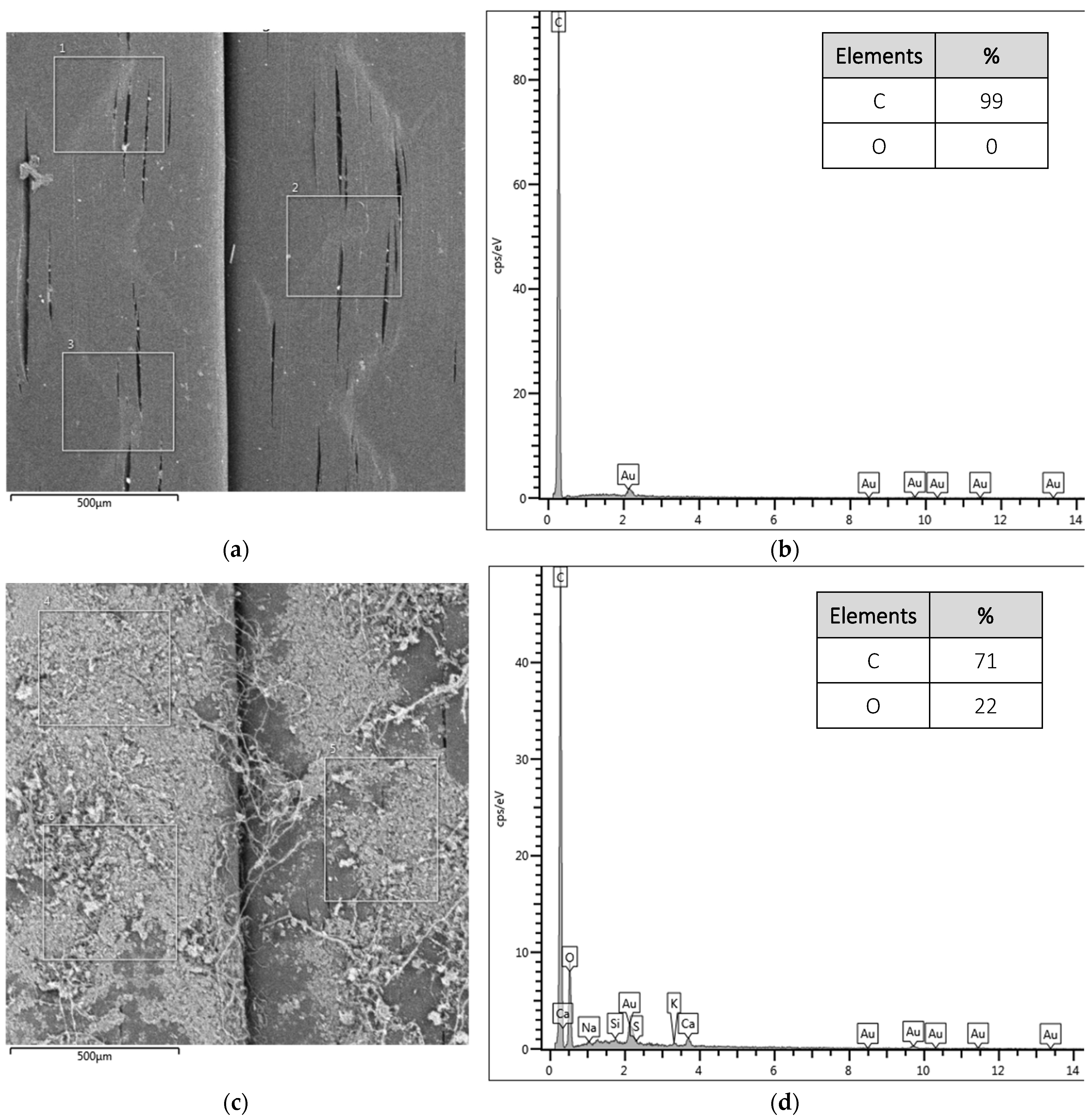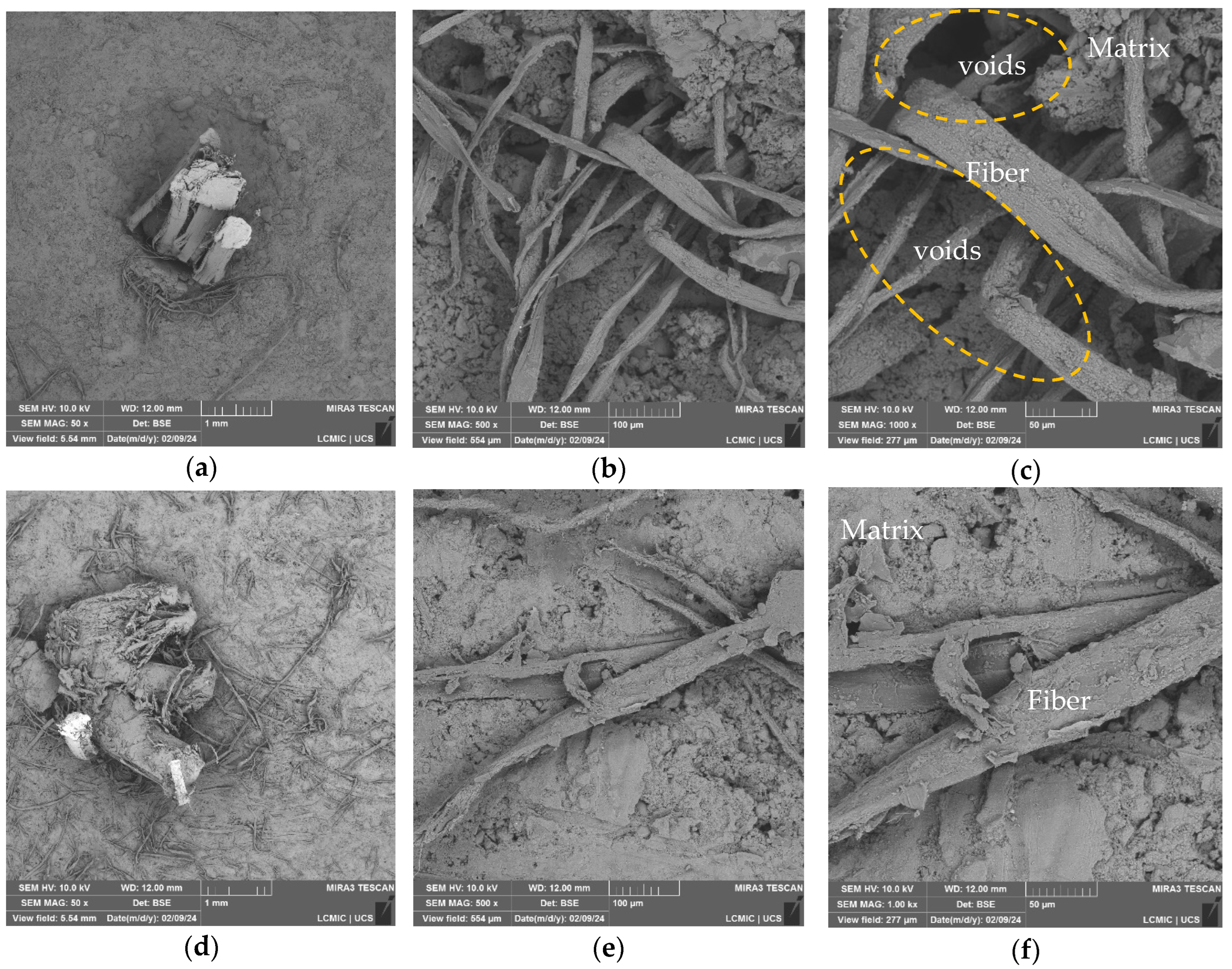Effect of Graphene Oxide Surface Deposition Process on Synthetic Macrofibers and Its Results on the Microstructure of Fiber-Reinforced Concrete
Abstract
:1. Introduction
2. Materials and Methods
2.1. Graphene Oxide
2.2. Coupling Agent
2.3. Additive
2.4. Macrofibers
2.5. Fiber Treatment
2.6. Production of Macrofiber-Reinforced Concretes
2.7. Assessment of Surface Deposition on Synthetic Macrofibers
3. Results and Discussion
3.1. Scanning Electron Microscopy (SEM-FEG) of the Fibers
3.2. Energy-Dispersive Spectroscopy (EDS) of Fibers


3.3. Scanning Electron Microscopy (SEM-FEG) of Concrete Reinforced with Macrofiber
3.4. Energy-Dispersive Spectroscopy (EDS) of Concrete Reinforced with Macrofiber
4. Conclusions
Author Contributions
Funding
Institutional Review Board Statement
Data Availability Statement
Acknowledgments
Conflicts of Interest
References
- Huang, H.; Yuan, Y.; Zhang, W.; Zhu, L. Property Assessment of High-Performance Concrete Containing Three Types of Fibers. Int. J. Concr. Struct. Mater. 2021, 15, 39. [Google Scholar] [CrossRef]
- Wang, X.; Li, L.; Xiang, Y.; Wu, Y.; Wei, M. The influence of basalt fiber on the mechanical performance of concrete-filled steel tube short columns under axial compression. Front. Mater. 2024, 10, 1332269. [Google Scholar] [CrossRef]
- Khayat, K.H.; Meng, W.; Vallurupalli, K.; Teng, L. Rheological properties of ultra-high-performance concrete—An overview. Cem. Concr. Res. 2019, 124, 105828. [Google Scholar] [CrossRef]
- Shafei, B.; Kazemian, M.; Dopko, M.; Najimi, M. State-of-the-Art Review of Capabilities and Limitations of Polymer and Glass Fibers Used for Fiber-Reinforced Concrete. Materials 2021, 14, 409. [Google Scholar] [CrossRef] [PubMed]
- Li, Z.; Zhang, Z.; Fei, M.-E.; Shi, X. Upcycling waste mask PP microfibers in portland cement paste: Surface treatment by graphene oxide. Mater. Lett. 2022, 318, 132238. [Google Scholar] [CrossRef]
- Noh, H.W.; Truong, V.D.; Cho, J.Y.; Kim, D.J. Dynamic increase factors for fiber-reinforced cement composites: A review. J. Build. Eng. 2022, 56, 104769. [Google Scholar] [CrossRef]
- Wen, C.; Zhang, P.; Wang, J.; Hu, S. Influence of fibers on the mechanical properties and durability of ultra-high-performance concrete: A review. J. Build. Eng. 2022, 52, 104370. [Google Scholar] [CrossRef]
- He, S.; Chen, Y.; Liang, M.; Yang, E.-H.; Schlangen, E. Distribution of porosity surrounding a microfiber in cement paste. Cem. Concr. Compos. 2023, 142, 104370. [Google Scholar] [CrossRef]
- Wu, S.; Qureshi, T.; Wang, G. Application of Graphene in Fiber-Reinforced Cementitious Composites: A Review. Energies 2021, 14, 4614. [Google Scholar] [CrossRef]
- Lu, L.; Zhao, P.; Lu, Z. A short discussion on how to effectively use graphene oxide to reinforce cementitious composites. Constr. Build. Mater. 2018, 189, 33–41. [Google Scholar] [CrossRef]
- Lu, Z.; Yao, J.; Leung, C.K. Using graphene oxide to strengthen the bond between PE fiber and matrix to improve the strain hardening behavior of SHCC. Cem. Concr. Res. 2019, 126, 105899. [Google Scholar] [CrossRef]
- Cecconello, V.; Poletto, M. Assessment of graphene oxide coated polyester fiber reinforced cementitious composites. J. Mater. Res. Technol. 2023, 27, 8216–8227. [Google Scholar] [CrossRef]
- Liu, B.; Wang, L.; Pan, G.; Li, D. Dispersion of graphene oxide modified polycarboxylate superplasticizer in cement alkali solution for improving cement composites. J. Build. Eng. 2022, 57, 104860. [Google Scholar] [CrossRef]
- Lu, Z.; Yu, J.; Yao, J.; Hou, D. Experimental and molecular modeling of polyethylene fiber/cement interface strengthened by graphene oxide. Cem. Concr. Compos. 2020, 112, 103676. [Google Scholar] [CrossRef]
- ASTM D1238; American Society for Testing and Materials, Standard Test Method for Melt Flow Rates of Themoplastic by Extrusion Plastomer. ASTM: West Conshohocken, PA, USA, 2013.
- Garcia-Diaz, Y.; Torres-Ortega, R.; Tovar, C.T.; Quiñones-Bolaños, E.; Saba, M. Characterization of pull-out behavior in the fiber–mortar interface with superficial treatments. Constr. Build. Mater. 2021, 303, 124474. [Google Scholar] [CrossRef]
- Serafini, R.; Dantas, S.R.; Salvador, R.P.; Agra, R.R.; Rambo, D.A.; Berto, A.F.; de Figueiredo, A.D. Influence of fire on temperature gradient and physical-mechanical properties of macro-synthetic fiber reinforced concrete for tunnel linings. Constr. Build. Mater. 2019, 214, 254–268. [Google Scholar] [CrossRef]
- Rocha, T.d.S.; Cardoso, D.C.; Bitencourt, L.A., Jr. Macro synthetic fiber pullout behavior in short- and long-term tests. Constr. Build. Mater. 2023, 384. [Google Scholar] [CrossRef]
- Cardoso, S.G.; Andrade, A.H.P. Study of Fracture Mechanisms of High Performance Polyester Synthetic Fibers. In Proceedings of the 11th International Conference on Advanced Materials ICAM 2009, Rio de Janeiro, Brazil, 20–25 September 2009. [Google Scholar]
- Li, X.; Lu, Z.; Chuah, S.; Li, W.; Liu, Y.; Duan, W.H.; Li, Z. Effects of graphene oxide aggregates on hydration degree, sorptivity, and tensile splitting strength of cement paste. Compos. Part A Appl. Sci. Manuf. 2017, 100, 1–8. [Google Scholar] [CrossRef]
- Devi, S.C.; Khan, R.A. Effect of Sulfate Attack and Carbonation in Graphene Oxide–Reinforced Concrete Containing Recycled Concrete Aggregate. J. Mater. Civ. Eng. 2020, 32, 04020339. [Google Scholar] [CrossRef]
- Singh, S.; Shukla, A.; Brown, R. Pullout behavior of polypropylene fibers from cementitious matrix. Cem. Concr. Res. 2004, 34, 1919–1925. [Google Scholar] [CrossRef]
- Pan, Z.; He, L.; Qiu, L.; Korayem, A.H.; Li, G.; Zhu, J.W.; Collins, F.; Li, D.; Duan, W.H.; Wang, M.C. Mechanical properties and microstructure of a graphene oxide–cement composite. Cem. Concr. Compos. 2015, 58, 140–147. [Google Scholar] [CrossRef]
- Chougan, M.; Lamastra, F.R.; Caschera, D.; Kaciulis, S.; Bolli, E.; Mazzuca, C.; Ghaffar, S.H.; Al-Kheetan, M.J.; Montesperelli, G.; Bianco, A. Cementitious nanocomposites engineered with high-oxidized graphene oxide: Spotting the nano to macro correlation. Ceram. Int. 2023, 49, 964–973. [Google Scholar] [CrossRef]
- Lamba, N.; Raj, R.; Singh, P. Feasibility of Recycled Carbon Fiber-Reinforced Polymer Fibers in Cementitious Composites: An Experimental Investigation. Arab. J. Sci. Eng. 2024, 49, 1–15. [Google Scholar] [CrossRef]
- Yuan, H.; Fan, Y.; You, X.; Fu, B.; Zou, Q. Pullout behavior of recycled macro fibers in the cementitious matrix: Analytical model and experimental validation. Compos. Struct. 2024, 328, 117690. [Google Scholar] [CrossRef]
- Hampe, A.; Kalinka, G.; Meretz, S.; Schulz, E. An advanced equipment for single-fibre pull-out test designed to monitor the fracture process. Composites 1995, 26, 40–46. [Google Scholar] [CrossRef]
- Sigrüner, M.; Muscat, D.; Strübbe, N. Investigation on pull-out behavior and interface critical parameters of polymer fibers embedded in concrete and their correlation with particular fiber properties. J. Appl. Polym. Sci. 2021, 138, 50745. [Google Scholar] [CrossRef]
- Yuan, Z.; Jia, Y. Mechanical properties and microstructure of glass fiber and polypropylene fiber reinforced concrete: An experimental study. Constr. Build. Mater. 2021, 266, 121048. [Google Scholar] [CrossRef]
- Balgourinejad, N.; Haghighifar, M.; Madandoust, R.; Charkhtab, S. Experimental study on mechanical properties, microstructural of lightweight concrete incorporating polypropylene fibers and metakaolin at high temperatures. J. Mater. Res. Technol. 2022, 18, 5238–5256. [Google Scholar] [CrossRef]
- Li, L.; Cao, M.; Li, Z.; Zhang, W.; Shi, D.; Shi, K. Uniaxial tensile behavior and mechanism characterization of multi-scale fiber-reinforced cementitious materials. Mater. De Construcción 2022, 72, e271. [Google Scholar] [CrossRef]
- López-Buendía, A.M.; Romero-Sánchez, M.D.; Climent, V.; Guillem, C. Surface treated polypropylene (PP) fibres for reinforced concrete. Cem. Concr. Res. 2013, 54, 29–35. [Google Scholar] [CrossRef]
- Wang, B.; Jiang, R.; Wu, Z. Investigation of the Mechanical Properties and Microstructure of Graphene Nanoplatelet-Cement Composite. Nanomaterials 2016, 6, 200. [Google Scholar] [CrossRef] [PubMed]






| Macrofiber A | Macrofiber B | |
|---|---|---|
| Polymer | Polypropylene | Polypropylene |
| Tensile strength (MPa) | 379.1 | 640 |
| Modulus of elasticity (GPa) | 5.2 | 12 |
| Length (mm) | 48 | 48 |
| MFR (g/10 min) | 10.54 ± 0.24 | 0.52 ± 0.01 |
| Application | Reinforcement in concrete | Reinforcement in concrete |
| Mixtures | Cement (g) | Natural Sand (g) | Crushing Sand (g) | Water (g) | SP (g) |
|---|---|---|---|---|---|
| FRC | 1011.28 | 926.13 | 617.42 | 404.43 | 9.15 |
| FRC/GO | 1011.28 | 926.13 | 617.42 | 404.43 | 9.15 |
Disclaimer/Publisher’s Note: The statements, opinions and data contained in all publications are solely those of the individual author(s) and contributor(s) and not of MDPI and/or the editor(s). MDPI and/or the editor(s) disclaim responsibility for any injury to people or property resulting from any ideas, methods, instructions or products referred to in the content. |
© 2024 by the authors. Licensee MDPI, Basel, Switzerland. This article is an open access article distributed under the terms and conditions of the Creative Commons Attribution (CC BY) license (https://creativecommons.org/licenses/by/4.0/).
Share and Cite
Cecconello, V.; Poletto, M. Effect of Graphene Oxide Surface Deposition Process on Synthetic Macrofibers and Its Results on the Microstructure of Fiber-Reinforced Concrete. Polymers 2024, 16, 1168. https://doi.org/10.3390/polym16081168
Cecconello V, Poletto M. Effect of Graphene Oxide Surface Deposition Process on Synthetic Macrofibers and Its Results on the Microstructure of Fiber-Reinforced Concrete. Polymers. 2024; 16(8):1168. https://doi.org/10.3390/polym16081168
Chicago/Turabian StyleCecconello, Vinício, and Matheus Poletto. 2024. "Effect of Graphene Oxide Surface Deposition Process on Synthetic Macrofibers and Its Results on the Microstructure of Fiber-Reinforced Concrete" Polymers 16, no. 8: 1168. https://doi.org/10.3390/polym16081168







